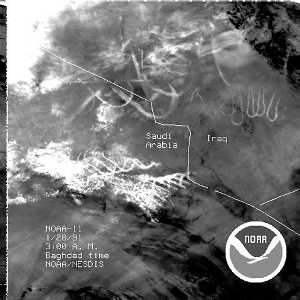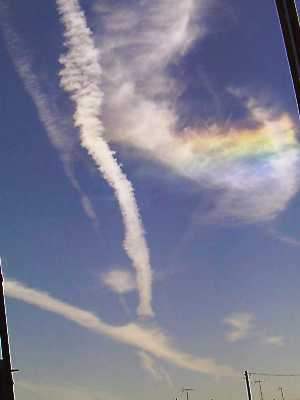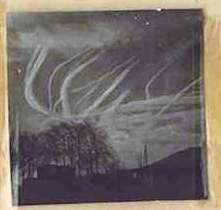...if you go to this site, at the bottom is a graph, citing most if not all of the symptoms experienced by people at large now that the tech is deployed and working daily above us...it will all be very familiar to you I am sure....we ALL have gulf war illness now....bush himself is the gulf war germ....we need some medicine to kill that germ....and soon....the doctors mention radiation all through their publications but seem at a loss, no, ARE at a loss to explain where the radiation is coming from, BECAUSE THEY ARE IGNORANT OF THE SCIENCE WE HAVE BEEN DOCUMENTING AND RESEARCHING!!!!
http://www.immed.org/publications/gulf_war_illness/JOMT-N.html
International Journal of Occupational Medicine and Toxicology 4: 365-370, 1995.
Progress on Persian Gulf War Illnesses--
Reality and Hypotheses
Garth L. Nicolson, Ph.D., Edward Hyman, M.D., Col. Andre s Kor yi-Both, M.D.,
Damacio A. Lopez, Nancy Nicolson, Ph.D.,
William Rea, M.D., and Harold Urnovitz, Ph.D.
Approximately 100,000 veterans in the US and approximately 4,000 in allied countries that served in Operation Desert Storm have subsequently presented with a variety of ailments, but the most common complaints have been the appearance of a collection of chronic symptoms that do not fit easily with any known syndrome. This condition has been called Gulf War Illness or Desert Storm Syndrome, and its origin and cause(s) have remained ellusive. The most common symptoms of Gulf War Illness include aching joints, chronic fatigue, memory loss, headaches, sleeping difficulties, skin rashes, loss of concentration, depression, muscle spasms, nervousness, diarrhea, blurred vision, anxiety, problems breathing, chest and heart pain, dizziness, nausea, stomach pain, sight sensitivity, loss of balance, hives, frequent coughing, chemical sensitivities, bleeding gums, eye pain and other vision problems and bleeding gums and other dental problems (see the Figure). Not shown in this figure are the autoimmune-like symptoms (thyroid, CNS, GI) seen in some veterans. In some cases, immediate family members have also presented with similar symptoms, suggesting that in a subset of Desert Storm veterans the disorder is transmittable. Veterans Administration data indicate that at least 1,300 veterans have died from cancers and several thousand more have died from other diseases.
In an effort to identify possible diseases or syndromes that could account for the variety of symptoms listed above, develop appropriate diagnostic tests, provide potential treatments, assist veterans with these disorders and initiate and coordinate political efforts on behalf of afflicted veterans, a Persian Gulf War National Unity Conference was convened in Irving, Texas on March 10-12, 1995 to bring together representatives from all states and experts from a variety of fields to discuss Gulf War Illnesses. Previously a Technology Assessment Workshop was organized by the NIH with the task of examining information and reports on Gulf Illnesses, recommending working case definitions for those illnesses, developing plausible etiologies and biological explanations for the illnesses. A report on this conference has appeared.1
The Medical/Scientific Panel of the Gulf War National Unity Conference met and considered the collective symptoms listed in the Figure and concluded, similar to previous panels, that they do not fit easily with any known syndrome or disease; therefore, multiple disorders were probably represented in these veterans. In some of the Desert Shield/Storm veterans that have multiple chronic symptoms, the causes may eventually be linked to endogenous sources, such as fine sand, and chemical exposures in the Gulf. Soldiers were exposed to oil spills and fires, smoke from military operations, chemicals on clothing, pesticides, chemoprophylactic agents, chemical weapons, among others. This exposure may have resulted in some cases in multiple chemical sensitivity syndrome (MCS). MCS shares some but not all of the symptoms listed in the Figure, but in some of the soldiers the infectious nature of the illnesses and its apparent spread to immediate family members precluded simple explanations, such as exposure to sand and toxic chemicals that were present at certain Persian Gulf locations. In this latter subset of veterans the causes may be linked to local infectious diseases or exposures to biological weapons.
Continuous exposure to fine sand particles (
Contamination by chemicals in the environment appears to be responsible for the MCS seen in many Gulf War veterans. William Rea (Environmental Health Center, Dallas) discussed progress in treating MCS. Similar to many nonveteran MCS patients, 80% of Desert Storm veterans with MCS responded to pollutant avoidance, nutrient supplementation, allergin tollerization and physical therapy.3,4 This subset of Gulf War Illness patients showed marked imporvement in their MCS symptoms after combination therapy.
Another contaminant of the Desert Storm environment was the presence of depleted uranium in ammunition and on battlefield weapons and damaged armored vehicles. Damancio Lopez (Bernalillo, New Mexico) discussed the health hazards of depleted uranium, which include radiation and heavy metal exposure. Depleted uranium contains about 30% of the normal amounts of the isotope 235U, a dangerous radioisotope with a half-life of over 4 billion years. Depleted uranium particles can be easily inhaled in smoke resulting from impact of armor piercing projectiles on hard targets and aerosolization of uranium into small particles. If even one small particle (
Exposure to environmental agents (radiation, chemical and biological agents) can result in activation of endogenous retroviruses.5 Howard Urnovitz (Calypte Biomedical, Berkeley) presented his results from a pilot study of Desert Storm veterans and their families from Portland, Oregon who presented with Gulf War Illnesses. Blood samples were tested for the presence of antibodies against epitopes of recombinant retroviral glycoproteins of human endogenous retrovirus (HERV). Anti-HERV antibodies were found in 13/15 Desert Storm veterans, 8/10 spouses and 4/5 children with Gulf War Illnesses. HERV activation is often seen in autoimmune neurologic disorders and severe infections,6 such as AIDS. Thus the high frequency of HERV activation in Gulf War Illnesses may be symptomatic of exposure to chemical and biological agents during Operation Desert Storm.
That Gulf War veterans may have been exposed to endogenous or exogenous biological agents was considered by Edward Hyman (New Orleans). He presented evidence indicating that a large proportion of the American and British veterans of Desert Storm, and in some cases their spouses and children, may be infected with bacteria, as documented by the presence of Gram positive cocci and their residues in urine.7 Using antibiotic treatment, Hyman has been able to successfully treat a subset of 15 veterans and their family members. These patients had complex symptoms that disappeared with successful antibiotic treatments.
Further evidence for the presence of unusual biological agents in Desert Storm veterans and their families was presented by Garth Nicolson (M. D. Anderson Cancer Center, Houston). He and Nancy Nicolson (Rhodon Foundation, Houston) presented their results on the presence of unusual highly pathogenic mycoplasmas, such as Mycoplasma fermentans (incognitus strain) and other mycoplasmas, in 11/20 of veterans and their family members who suffer from Gulf War Illnesses. The specific mycoplasmas were detected in the leukocyte fraction of blood samples by the highly sensitive technique of Gene Tracking.8 In their study of 73 Desert Storm veterans and their symptomatic spouses and children without MCS, 55 showed good responses and eventually recovered with multiple cycles of doxycycline treatment,9 an antibiotic that is particularly effective against mycoplasma infections.10 They concluded that many Desert Storm veterans with Gulf War Illness, particularly a subset with family members that are presenting with similar symptoms, are infected with invasive microorganisms, such as mycoplasmas and possibly other infectious agents as well. Since the mycoplasmas detected appeared to contain unusual gene sequences (such as the HIV-1 envelope gene), the Nicolsons concluded that the mycoplasmas were probably modified and may have been used as biological weapons during Desert Storm.
The Medical/Scientific Panel concluded that although initial progress on Gulf War Illnesses was encouraging, further research was absolutely necessary to identify the sources of the illnesses, develop useful diagnostic tests for the various illnesses represented in Desert Storm veterans, and initiate clinical trials. The most pressing difficulty for most of the investigators working on Gulf War Illnesses has been the appalling lack of financial support for their studies and the failure of the Veterans Administration to cooperate with diagnostic and therapeutic clinical trials. Without the necessary resources and cooperation, the initial findings presented at the Gulf War Unity Conference cannot be exploited or expanded to include the vast numbers of veterans and their family members who suffer from the multiple disorders called Gulf War Illnesses.
Garth L. Nicolson, Ph.D., Panel Chairman
Department of Tumor Biology-108
The University of Texas M. D. Anderson Cancer Center
Houston, TX 77030 Fax 713-794-0209
(click here for current address and telno)
Edward Hyman, M.D.
3525 Prytania Street
New Orleans, LA 70115 Fax 504-891-2858
Col. Andre s Kor yi-Both, M.D.
Department of Military Affairs
Adjutant General's Office
Fort Indiantown Gap
Annville, PA 17003-5002 Fax 610-353-6036
Damacio A. Lopez
P.O. Box 1688
Bernalillo, NM 87004 Fax 505-867-0569
Nancy Nicolson, Ph.D.
Rhodon Foundation for Biomedical Research
Kingwood, TX 77339 Fax 713-358-7528
William Rea, M.D.
Environmental Health Center-Dallas
Dallas, TX 75231 Fax 214-691-8434
Harold Urnovitz, Ph.D.
Calypte Biomedical
Berkeley, CA 94710 Fax 510-526-5381
References
1. NIH Technology Assessment Workshop Panel. The Persian Gulf Experience and Health. JAMA 1994; 272: 391-396.
2. Kor nyi-Both AL, Kor nyi-Both AL, Fidelus-Gort RF. Al Eskan Disease--Persian Gulf Syndrome. Military Med 1992; 157: 452-462.
3. Ross GH, Rea WJ, Johnson AR, Maynard BJ, Carlisle L. Evidence for vitamin dificiencies in environmentally-sensitive patients. Clin Ecology 1989; 6(2):60-66.
4. Rea WJ, Pan Y, Johnson AR, Ross GH, Suyama H, Fenyves EJ. Reduction of chemical sensitivity by means of heat deprivation, physical therapy, and nutritional supplementation in a controlled environment. J Nutrit Environ Med 1996; 6: 141-148.
5. Urnovitz HB, Murphy WH. Human endogeneous retroviruses: nature, occurrence and clinical implications in human disease. Clin Microbiol Rev 1995; in press.
6. Abraham GN, Khan AS. Human endogenous retroviruses and immune disease. Clin Immunol Immunopathol 1990; 56: 1-8.
7. Hyman ES. A urinary marker for systemic coccal disease. Nephron 1994; 68: 314-326.
8. Nicolson NL, Nicolson GL. The isolation, purification and analysis of specific gene-containing nucleoproteins and nucleoprotein complexes. Meth Mol Genet 1994; 5: 281-298.
9. Nicolson GL, Nicolson NL. Doxycycline treatment and Desert Storm JAMA 1995; 273: 618-619.
10. Lo S-C, Buchholz CL, Wear DJ, Hohm RC, Marty AM. Histopathology and doxycycline treatment in a previously healthy non-AIDS patient systemically infected by Mycoplasma fermentans (incognitus strain). Mod Pathol 1991; 6: 750-754.
Figure Legend. The symptoms of approximately 650 Desert Storm veterans with Gulf War Illnesses (data from Garth Nicolson).
Top of Page
File: research/!IJOMT-N.html





